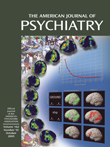Risperidone-Induced Immunoallergic Hepatitis
To the Editor: Mechanisms of reported risperidone-induced hepatotoxicity remain unclear (1). We report a case of risperidone-induced cytolytic hepatitis, suggesting an immunoallergic reaction.
Mr. A, a 28-year-old Caucasian man with paranoid schizophrenia, was administered risperidone (titrated up to 8 mg/day within 5 weeks) because of a reappearance of auditory hallucinations and thought disorder after he had been free of all medications for 12 months.
After 7 weeks of outpatient risperidone monotherapy, elevated levels of serum aspartate aminotransferase (AST) (83 U/liter, normal=10–50) and alanine aminotransferase (ALT) (123 U/liter, normal=10–60) were observed. The results of cholestatic blood measurements, WBC and RBC counts, and coagulation tests were normal. Mr. A’s medical history did not reveal autoimmune or allergic disease. There was no history of alcohol or substance abuse, except occasional hashish smoking. During Mr. A’s previous hospitalization (4 years earlier), while he was receiving haloperidol, his serum transaminase levels had been normal.
His ALT and AST levels markedly increased during the 8th week of treatment (AST=139 U/liter, ALT=522 U/liter). Mr. A developed nausea, vomiting, and epigastric pain. Hospitalization was decided upon, and risperidone treatment was discontinued.
An abdominal ultrasound was normal. Serological markers for viral hepatitis A, B, and C were negative. Determinations of ceruloplasmin and copper in his serum were also normal. His WBC count showed eosinophilia (850 cells/mm3, normal<500), and laboratory analyses for autoimmune diseases revealed high levels of anti-smooth-muscle antibodies (titer=1:640), without actin or vimentin specificity. Tests for anti-liver-kidney microsomal enzymes, antisoluble liver antigen, and antinuclear and antimitochondrial auto-antibodies were negative.
With treatment consisting only of loxapine (200 mg/day) and oxazepam (200 mg/day), Mr. A’s AST and ALT levels returned to normal within 3 weeks. One month after risperidone discontinuation, his anti-smooth-muscle antibodies titer had decreased to 1:100, and his eosinophil level had returned to normal. Mr. A was then given haloperidol (20 mg/day), and his serum transaminase levels remained normal.
The temporal relationship between risperidone exposure and serum liver enzyme elevations, deterioration under continuing risperidone treatment, an immediate decrease in liver enzyme abnormalities after risperidone discontinuation, and the exclusion of other causes made us classify our case as probable risperidone-induced hepatotoxicity, according to the scale of Naranjo and colleagues (2).
Risperidone is metabolized to its active metabolite (9-OH-risperidone) by cytochrome P450 (CYP) 2D6 (3). In slow metabolizers of CYP2D6, marked differences in the pharmacokinetic profile of risperidone and 9-OH-risperidone might increase the risk of liver toxicity (1). In our patient, this hypothesis was not supported by the CYP2D6 genotype (CYP2D6*1/CYP2D6*5), which corresponds to the CYP2D6 rapid metabolizer phenotype. However, a metabolic type of idiosyncratic toxicity resulting from rare CYP2D6 mutations other than CYP2D6*3,CYP2D6*4, and CYP2D6*5 cannot be ruled out.
Eosinophilia and high levels of anti-smooth-muscle antibodies suggest a risperidone-induced immunoallergic reaction (4). The significant decreases in the patient’s eosinophil count and anti-smooth-muscle antibodies levels after risperidone discontinuation support this hypothesis. The possibility of drug-induced immunoallergic hepatitis must therefore be kept in mind when initiating treatment with risperidone.
1. Benazzi F: Risperidone-induced hepatotoxicity. Pharmacopsychiatry 1998; 31:241Crossref, Medline, Google Scholar
2. Naranjo CA, Busto U, Sellers EM, Sandor P, Ruiz I, Roberts EA: A method for estimating the probability of adverse drug reactions. Clin Pharmacol Ther 1981; 30:239–245Crossref, Medline, Google Scholar
3. Ereshefsky L: Pharmacokinetics and drug interactions: update for new antipsychotics. J Clin Psychiatry 1996; 11:12–25Google Scholar
4. Lee WM: Drug-induced hepatotoxicity. N Engl J Med 1995; 333:1118–1127Crossref, Medline, Google Scholar



